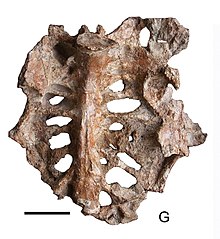
Back Gargantuavis Czech Gargantuavis German Gargantuavis Spanish Gargantuavis French גרגנטואוויס HE Gargantuavis philoinos Italian Gargantuavis Polish Gargantuavis philoinos Ukrainian 卡岡杜亞鳥屬 Chinese
| Gargantuavis Temporal range: Late Cretaceous,
| |
|---|---|

| |
| The holotype of Gargantuavis philoinos, a partial pelvis from Campagne-sur-Aude | |
| Scientific classification | |
| Domain: | Eukaryota |
| Kingdom: | Animalia |
| Phylum: | Chordata |
| Clade: | Dinosauria |
| Clade: | Saurischia |
| Clade: | Theropoda |
| Clade: | Avialae |
| Family: | †Gargantuaviidae Buffetaut and Angst, 2019 |
| Genus: | †Gargantuavis Buffetaut & Le Loeuff, 1998 |
| Species: | †G. philoinos
|
| Binomial name | |
| †Gargantuavis philoinos Buffetaut & Le Loeuff, 1998
| |
Gargantuavis (meaning 'gargantuan bird') is an extinct genus of large, primitive bird containing the single species Gargantuavis philoinos.[1] It is the only member of the monotypic family Gargantuaviidae. Its fossils were discovered in several formations dating to 73.5 and 71.5 million years ago in what is now northern Spain, southern France, and Romania.[2][3] Gargantuavis is the largest known bird of the Mesozoic, a size ranging between the cassowary and the ostrich, and a mass of 141 kg (311 lb) like modern ostriches, exemplifying the extinction of non-avian dinosaurs was not a necessary condition for the emergence of giant terrestrial birds.[1] It was once thought to be closely related to modern birds, but the 2019 discovery of a pelvis identified as cf. Elopteryx nopcsai from what was Hateg Island (present-day Romania) shows several primitive features.[4]
Its femur shows that it was a graviportal form rather than cursorial, not adapted for running.[5] Due to fragmentary remains, many aspects of its biology and ecology are unknown, such as its diet. It coexisted with large predators like abelisaurid theropods, herbivores such as ankylosaurians and titanosaurian sauropods, as well as pterosaurs, crocodylomorphs, turtles, fish, and various archaic birds.[1][6][2]
- ^ a b c Buffetaut, E.; Le Loeuff, J. (1998). "A new giant ground bird from the Upper Cretaceous of southern France". Journal of the Geological Society, London. 155 (155): 1–4. Bibcode:1998JGSoc.155....1B. doi:10.1144/gsjgs.155.1.0001. S2CID 128496095.
- ^ a b Buffetaut, E.; Angst, D. (2016). "The giant flightless bird Gargantuavis philoinos from the Late Cretaceous of southwestern Europe: a review". In Khosla, A.; Lucas, S.G. (eds.). Cretaceous Period: Biotic Diversity and Biogeography. Albuquerque: New Mexico Museum of Natural History and Science Bulletin 71. pp. 45–50.
- ^ Buffetaut, E.; Angst, D. (2016). "Pelvic elements of the giant bird Gargantuavis from the Upper Cretaceous of Cruzy (southern France), with remarks on pneumatisation". Cretaceous Research. 66 (66): 171–176. Bibcode:2016CrRes..66..171B. doi:10.1016/j.cretres.2016.06.010.
- ^ Cite error: The named reference
Mayr2019was invoked but never defined (see the help page). - ^ Buffetaut, E.; Le Loeuff, J. (2010). "Gargantuavis philoinos: giant bird or giant pterosaur?". Annales de Paléontologie. 96 (4): 135–141. Bibcode:2010AnPal..96..135B. doi:10.1016/j.annpal.2011.05.002.
- ^ Buffetaut, E. (2012). "Les oiseaux fossiles du Crétacé supérieur de l'Hérault". Bulletin de la Société d'Étude des Sciences Naturelles de Béziers (66): 34–39.
© MMXXIII Rich X Search. We shall prevail. All rights reserved. Rich X Search